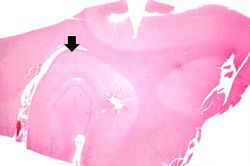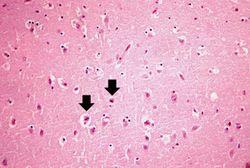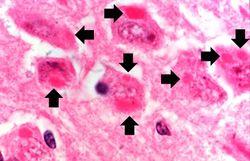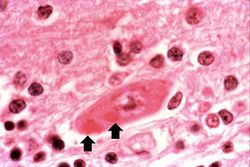Difference between revisions of "IPLab:Lab 8:Rabies"
Seung Park (talk | contribs) |
|||
| Line 11: | Line 11: | ||
File:IPLab8Rabies5.jpg|This is a high-power photomicrograph of a neuron surrounded by inflammatory cells (lymphocytes and microglia). This neuron has two intracytoplasmic eosinophilic inclusion bodies (arrows). | File:IPLab8Rabies5.jpg|This is a high-power photomicrograph of a neuron surrounded by inflammatory cells (lymphocytes and microglia). This neuron has two intracytoplasmic eosinophilic inclusion bodies (arrows). | ||
</gallery> | </gallery> | ||
| + | |||
| + | == Study Questions == | ||
| + | * <spoiler text="What are Negri bodies?">Negri bodies are the cytoplasmic, round to oval or bullet-shaped, eosinophilic inclusions that are most easily found in pyramidal neurons of the hippocampus and Purkinje cells of the cerebellum. The inclusion bodies are seen here because these sites are usually devoid of inflammation.</spoiler> | ||
| + | * <spoiler text="What is the usual pathogenesis of rabies?">Rabies is usually transmitted by the bite of a rabid animal. The virus enters the CNS by ascending along the peripheral nerves from the wound site. The incubation period varies depending on the distance between the wound and the brain (commonly between 1 and 3 months).</spoiler> | ||
| + | * <spoiler text="What is the usual clinical course of rabies?">The disease usually starts with nonspecific symptoms of malaise, headache, and fever, but the combination of these symptoms with local paresthesias around the site of the animal bite is diagnostic. In advanced cases, the patient exhibits severe CNS excitability progressing to convulsions. Contracture of the pharyngeal musculature when swallowing produces gagging and foaming at the mouth ("hydrophobia"). There is meningismus and, as the disease progresses, flaccid paralysis. Periods of alternating mania and stupor progress to coma and death from respiratory center failure.</spoiler> | ||
{{IPLab 8}} | {{IPLab 8}} | ||
[[Category: IPLab:Lab 8]] | [[Category: IPLab:Lab 8]] | ||
Revision as of 15:47, 21 August 2013
Clinical Summary
This 52-year-old female had been bitten by a dog two months previously. One week prior to death, she developed severe headache, restlessness, and dysphagia. These symptoms were followed by the appearance of fever, tremor, and general rigidity. The patient was admitted, but expired on the second hospital day.
Images
Study Questions
| |||||




